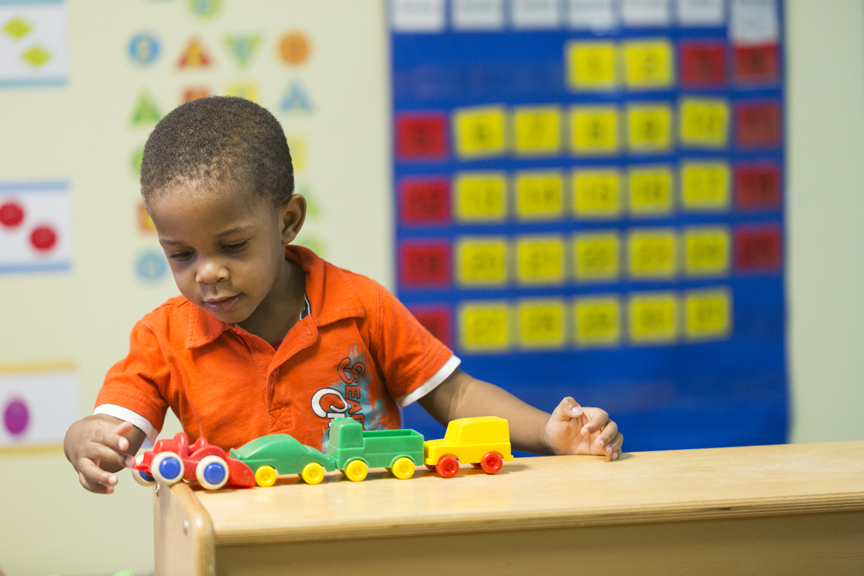- Behavior
- Education
- Health
Ages 3-5: Running, jumping, balancing and speaking clearly

In this article, you’ll find answers to questions like:
1. Should all kids develop at the same rate?
2. What percentage of kids are at risk for delays?
3. Who can help?
By 4 years old, most children can hop on one foot, ride a tricycle, define words, describe pictures and sing familiar songs.
If your child isn’t, perhaps it’s something to consider. The earlier developmental delays are identified and addressed, the better the outcome for the child will be.
As parents, we often hear the term developmental milestones and know it’s important our children hit these markers at key moments of growth. But what exactly do child development specialists mean by that phrase?
1. SHOULD ALL KIDS DEVELOP AT THE SAME RATE?
“First, it’s important to remember that every child is an individual,” says Randee Gabriel, programs manager at 211 Palm Beach/Treasure Coast. “There are no two children that will hit every milestone at the exact same time. Still, there are crucial cues to look for at each age.”
Gabriel explains children up to age 5 should reach milestones in how they play, learn, speak, act and move (see chart below).
“This is because a young child’s brain develops incredibly quickly,” says Gabriel, adding a newborn’s brain is about a fourth the size of an adult brain. By age 3, the brain grows to 80 percent of adult size on its way to 90 percent by age 5.
Developmental milestones at a glance
|
Age |
Gross motor |
Fine motor |
Cognitive, linguistic and communication |
Social-emotional |
|
3 years |
Balances on each foot; jumps on one foot |
Wiggles thumb; copies lines and circles; stacks towers of six to eight cubes; strings large beads |
Speaks more clearly; names colors and pictures; names seven body parts |
Names friends; brushes teeth with help; uses words to describe emotions (happy, sad) |
|
4 years |
Hops on one foot; rides a tricycle |
Draws a person with three parts; stacks towers of 10+ cubes; copies shapes |
Speaks more clearly; defines words; describes pictures; uses past tense and plurals |
Follows three unrelated directions; talks about activities; sings familiar songs; plays with others |
|
5 years |
Balances on each foot for 10 seconds or longer; somersaults (tuck and roll); swings |
Copies patterns; prints some letters; cuts with safety scissors |
Recalls parts of a story; speaks in sentences of more than five words; names opposites |
Wants to please friends; more agreeable to rules; likes to sing, dance, act |
2. WHAT PERCENTAGE OF KIDS ARE AT RISK?
One in four U.S. children up to age 5 are at moderate or high risk of developmental, behavioral or social delay, according to the U.S. Centers for Disease Control and Prevention. In addition, many children experience delays in language or other areas that can affect school readiness.
“Every age group brings within itself new changes and skills required,” Gabriel says. “While a child may have no concerns at 6 months, this does not guarantee there will be no concerns at 25 months or 48 months or beyond. Rescreening at each interval is imperative to identify these shifts and ensure healthy development over the long term.”
3. WHO CAN HELP?
Detection and intervention are critical for optimal outcomes for children. If you have questions or concerns about your child’s development, call 2-1-1 or chat online and ask for the Help Me Grow program. Help Me Grow services are free, including screenings, information and resource connection.
You can also call HomeSafe for a free screening at 561-383-9800.
SOURCES:
• Randee Gabriel, programs manager, 211 Palm Beach/Treasure Coast
• Centers for Disease Control and Prevention, U.S. Department of Health and Human Services
You May Also Like
-
- Education
- Other
- Parenting
What to seek in quality child care
Quality infant and toddler care, with low child-to-teacher ratios, is always the hardest type of child care to find. That means expectant parents should start looking before their …
Read More -
- Behavior
- Education
- Parenting
Start early, research and trust gut for selecting kindergarten
Do you have no idea where to start looking for your child's first school? Well, annual kindergarten roundups are a great way to assess schools and meet principals. Read on for more …
Read More -
- Behavior
- Health
- Parenting
Is your preschooler sleeping enough? And how does it help?
Ten to 13 hours a day, including naps, are recommended for children ages 3 to 5. Read on for more expert sleep advice. …
Read More
Related resources
-
- Behavior
- Education
- Health
211 Palm Beach Treasure Coast
Help Me Grow – information, guidance and developmental assessment of children up to age 8
2-1-1 Website Email -
- Education
- Health
School District of Palm Beach County
Child Find — screening, evaluation, services and placement of children with special learning needs
561-434-7337 Website -
- Education
- Other
- Parenting
Early Learning Coalition of Palm Beach County
Local child-care information, resource and referral, including help paying for care for eligible families
561-514-3300 Website -
- Education
- Parenting
School District of Palm Beach County
Early Childhood Education — information on Voluntary Pre-Kindergarten, Head Start and Early Head Start, which are designed to promote school readiness
561-969-5884 Website
